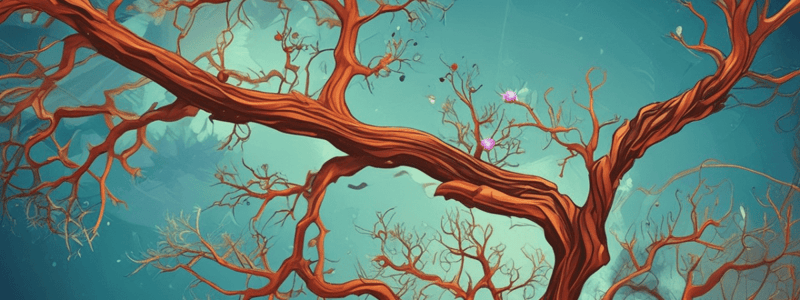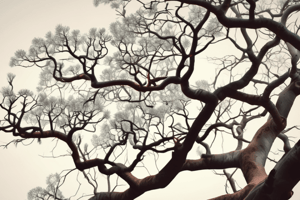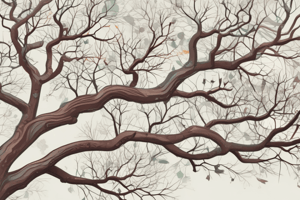Podcast
Questions and Answers
What is the study of interactions between organisms and their environment?
What is the study of interactions between organisms and their environment?
- Botany
- Ecology (correct)
- Microbiology
- Genetics
Which cell structure is responsible for generating energy for the cell?
Which cell structure is responsible for generating energy for the cell?
- Nucleus
- Mitochondria (correct)
- Cytoplasm
- Endoplasmic reticulum
What is the process by which cells create proteins?
What is the process by which cells create proteins?
- Cellular respiration
- Photosynthesis
- Cell division
- Protein synthesis (correct)
What is the study of the structure, function, and interactions of biomolecules?
What is the study of the structure, function, and interactions of biomolecules?
What is the process by which populations adapt to their environment?
What is the process by which populations adapt to their environment?
What is the graphical representation of genetic crosses?
What is the graphical representation of genetic crosses?
What is the study of the complete set of genetic information in an organism?
What is the study of the complete set of genetic information in an organism?
Flashcards are hidden until you start studying
Study Notes
Branches of Biology
- Botany: study of plants
- Zoology: study of animals
- Microbiology: study of microorganisms
- Ecology: study of interactions between organisms and their environment
- Biochemistry: study of chemical processes in living organisms
- Molecular Biology: study of structure, function, and interactions of biomolecules
- Cellular Biology: study of structure, function, and processes of cells
- Genetics: study of heredity, genes, and variation
- Evolutionary Biology: study of evolution, speciation, and phylogenetics
- Biophysics: study of physical principles underlying biological processes
Cell Biology
- Cell Structure:
- Plasma membrane: outermost layer of cell
- Cytoplasm: jelly-like substance inside cell
- Nucleus: control center of cell
- Mitochondria: energy-producing structures
- Endoplasmic reticulum: network of membranous tubules and cisternae
- Cell Processes:
- Photosynthesis: process by which plants produce energy
- Cellular respiration: process by which cells generate energy
- Protein synthesis: process by which cells create proteins
- Cell division: process by which cells reproduce
Genetics
- Mendelian Inheritance:
- Laws of Inheritance: segregation, independent assortment, and dominance
- Punnett squares: graphical representation of genetic crosses
- DNA Structure:
- Double helix model: twisted ladder-like structure
- Nucleotides: building blocks of DNA
- Genome: complete set of genetic information in an organism
- Gene Expression:
- Transcription: process by which DNA is copied into RNA
- Translation: process by which RNA is used to create proteins
Evolution
- Mechanisms of Evolution:
- Natural selection: process by which populations adapt to environment
- Genetic drift: random change in gene frequency
- Mutation: change in DNA sequence
- Gene flow: movement of genes between populations
- Evidence for Evolution:
- Fossil record: chronological record of ancient life forms
- Comparative anatomy: study of similarities and differences in body structure
- Molecular biology: study of similarities and differences in DNA and proteins
Branches of Biology
- Botany is the study of plants
- Zoology is the study of animals
- Microbiology is the study of microorganisms
- Ecology is the study of interactions between organisms and their environment
- Biochemistry is the study of chemical processes in living organisms
- Molecular Biology is the study of structure, function, and interactions of biomolecules
- Cellular Biology is the study of structure, function, and processes of cells
- Genetics is the study of heredity, genes, and variation
- Evolutionary Biology is the study of evolution, speciation, and phylogenetics
- Biophysics is the study of physical principles underlying biological processes
Cell Biology
Cell Structure
- The plasma membrane is the outermost layer of the cell
- Cytoplasm is the jelly-like substance inside the cell
- The nucleus is the control center of the cell
- Mitochondria are energy-producing structures
- The endoplasmic reticulum is a network of membranous tubules and cisternae
Cell Processes
- Photosynthesis is the process by which plants produce energy
- Cellular respiration is the process by which cells generate energy
- Protein synthesis is the process by which cells create proteins
- Cell division is the process by which cells reproduce
Genetics
Mendelian Inheritance
- The laws of inheritance include segregation, independent assortment, and dominance
- Punnett squares are a graphical representation of genetic crosses
DNA Structure
- The double helix model is a twisted ladder-like structure
- Nucleotides are the building blocks of DNA
- The genome is the complete set of genetic information in an organism
Gene Expression
- Transcription is the process by which DNA is copied into RNA
- Translation is the process by which RNA is used to create proteins
Evolution
Mechanisms of Evolution
- Natural selection is the process by which populations adapt to their environment
- Genetic drift is a random change in gene frequency
- Mutation is a change in DNA sequence
- Gene flow is the movement of genes between populations
Evidence for Evolution
- The fossil record is a chronological record of ancient life forms
- Comparative anatomy is the study of similarities and differences in body structure
- Molecular biology is the study of similarities and differences in DNA and proteins
Studying That Suits You
Use AI to generate personalized quizzes and flashcards to suit your learning preferences.




